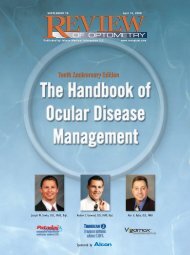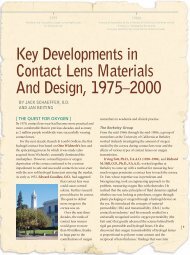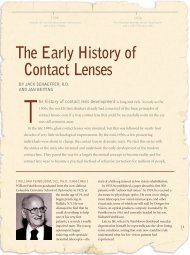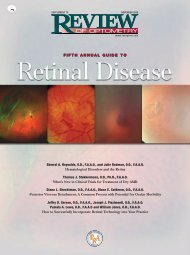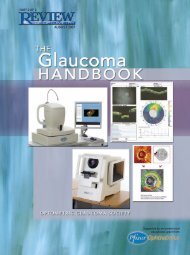Leaders of Yesterday, Today and Tomorrow
Leaders of Yesterday, Today and Tomorrow
Leaders of Yesterday, Today and Tomorrow
Create successful ePaper yourself
Turn your PDF publications into a flip-book with our unique Google optimized e-Paper software.
Late 1980s<br />
Reverse-geometry lens designs are introduced for post-RK patients.<br />
Dr. Korb invents Soothe, a metastable oil-in-water emulsion that has been shown to more than double the thickness<br />
<strong>of</strong> the lipid layer. It is now marketed <strong>and</strong> sold by Alimera Sciences.<br />
<strong>Leaders</strong> <strong>of</strong> <strong>Yesterday</strong>,<br />
<strong>Today</strong> <strong>and</strong> <strong>Tomorrow</strong><br />
BY JACK SCHAEFFER, O.D.<br />
AND JAN BEITING<br />
Following the introduction <strong>of</strong> contact lenses<br />
in the 1940s <strong>and</strong> 1950s <strong>and</strong> the rapid proliferation<br />
throughout the 1970s <strong>of</strong> new lens materials <strong>and</strong><br />
designs, the first true contact lens specialty practices<br />
began to emerge.<br />
In Part III <strong>of</strong> our series on pioneers in the contact<br />
lens field, we examine the groundbreaking practitioners<br />
who first eschewed spectacles to establish contact lensonly<br />
practices. Many <strong>of</strong> these individuals had an early<br />
interest in contact lenses <strong>and</strong> had been fitting rigid<br />
PMMA lenses since their introduction. So few doctors<br />
were fitting contact lenses at all that they rapidly<br />
became the recognized experts in their own<br />
communities, the educators <strong>of</strong> their peers <strong>and</strong><br />
consultants to industry. And their practices flourished.<br />
Many are still considered leading practices today.<br />
[ LAYING THE FOUNDATION ]<br />
Harold E. Davis, O.D., opened his practice in an<br />
industrial area near the Chicago stockyards <strong>and</strong><br />
slaughterhouses in 1945. A -12:00D myope who wore<br />
contact lenses himself, Dr. Davis <strong>of</strong>ten spent his lunch<br />
hour talking shop with his friends George N. Jessen,<br />
O.D., <strong>and</strong> Newton K. Wesley, O.D., whose Wesley<br />
Jessen Plastic Contact Lens Company was located about<br />
15 minutes away. “The science <strong>of</strong> contact lenses just<br />
embraced me,” Dr. Davis said. By the late 1950s, his<br />
practice was dedicated to them.<br />
He continues to practice full-time at Davis Eyecare<br />
Associates, along with his son, Robert L. Davis, O.D.<br />
“Although we have been successful, economics did not<br />
<strong>and</strong> still does not drive us,” said Dr. Harold Davis. “If<br />
you try to do the best you can for your patient, the rest<br />
will follow. That’s always the answer.”<br />
The same year that Dr. Davis launched his practice<br />
in Chicago, Charles “Ted” Bayshore, O.D., was<br />
opening his doors in Orl<strong>and</strong>o, Florida. An early fitter <strong>of</strong><br />
PMMA corneal lenses, Dr. Bayshore developed his own<br />
system <strong>of</strong> fitting <strong>and</strong> lectured about it around the<br />
world. By the early 1950s, his was a contact lens-only<br />
practice, as well. But, in addition to an interest in lens<br />
technology, Dr. Bayshore—who had run a Naval<br />
hospital in World War II—brought military<br />
organization to his civilian practice. He put a recall<br />
system in place, established state-<strong>of</strong>-the-art<br />
communication systems, <strong>and</strong> was one <strong>of</strong> the first to<br />
inventory <strong>and</strong> market his lenses, according to Jack<br />
Joseph Yager, O.D., who joined the practice in 1973<br />
<strong>and</strong> now owns it.<br />
Further up the East<br />
Coast, Paul Farkas, O.D.,<br />
<strong>and</strong> Theodore W.<br />
Kassalow, O.D., established<br />
one <strong>of</strong> the nation’s<br />
premiere, high-end<br />
optometric practices in New<br />
York City in 1958. The<br />
partners long ago decided<br />
not to accept third-party<br />
insurance (other than<br />
Paul Farkas, O.D.<br />
Medicare) <strong>and</strong> still don’t.<br />
They situated their practice on the second floor because<br />
ground level was considered “too commercial,” but<br />
Farkas & Kassalow was among the first practices to<br />
strike a middle ground between the business-oriented<br />
practice <strong>and</strong> the purely pr<strong>of</strong>essional practice to form an<br />
| 19
1989<br />
The FDA recommends that continuous-wear periods be decreased from 30 days to a maximum <strong>of</strong> seven days.<br />
20 |<br />
organization that sought to be pr<strong>of</strong>itable by providing<br />
the best pr<strong>of</strong>essional care for each <strong>and</strong> every patient.<br />
Key to the practice’s long-term success, says Barry<br />
Farkas, O.D., nephew <strong>of</strong> the founder, is having the<br />
flexibility to grow <strong>and</strong> change with the market, but<br />
always maintaining a specialist mentality. “That requires<br />
one to get involved early with the newest technologies<br />
to figure out who they work for <strong>and</strong> who they don’t,” he<br />
said. “And you can’t just rely on one or two favored<br />
lenses. We work with well over 300 different contact<br />
lenses, including many RGP lenses, daily disposables,<br />
multifocals, toric lenses, <strong>and</strong> specialty lenses for patients<br />
with keratoconus <strong>and</strong> other challenges.” The practice<br />
has evolved considerably as the younger generation<br />
joined—first Dr. Barry Farkas, followed by Theodore’s<br />
son Jordan Kassalow, O.D., <strong>and</strong> Susan Resnick, O.D.<br />
In St. Louis, another optometrist who had started<br />
dabbling in contact lenses early was Robert Koetting,<br />
O.D., the gr<strong>and</strong>son <strong>of</strong> an optician <strong>and</strong> son <strong>of</strong> an<br />
optometrist. “In 1962, I began to take contact lenses<br />
seriously <strong>and</strong> limited my practice to them,” he said. He<br />
decided early on that his key market was affluent<br />
presbyopes, <strong>and</strong> did whatever it took to reach that<br />
market segment, including advertising in airline<br />
magazines for business travelers, hiring a PR agency,<br />
<strong>and</strong> becoming an arts patron.<br />
“Koetting <strong>and</strong> the other early contact lens practices<br />
converted a novelty into a successful specialty practice<br />
<strong>and</strong> showed the way for the rest <strong>of</strong> us,” said Carmen F.<br />
Castellano, O.D., who now owns Koetting Associates.<br />
“The way I practice today is all based on Koetting’s<br />
philosophy <strong>of</strong> going above<br />
<strong>and</strong> beyond the st<strong>and</strong>ard,”<br />
he said.<br />
Another <strong>of</strong> Dr. Koetting’s<br />
lasting contributions was the<br />
concept <strong>of</strong> the contact lens<br />
technician. He was one <strong>of</strong> the<br />
first to utilize technical<br />
assistants <strong>and</strong> multiple exam<br />
rooms to see more patients<br />
N. Rex Ghormley, O.D., on the<br />
cover <strong>of</strong> the AOA journal in<br />
1975, five years after<br />
establishing his contact lens<br />
specialty practice.<br />
in a day. It was a concept that<br />
N. Rex Ghormley, O.D.,<br />
refined in his own practice.<br />
He opened Vision Care<br />
Consultants in St. Louis in<br />
1970, after working for<br />
Dr. Koetting for a few<br />
years, <strong>and</strong> focused<br />
exclusively on contact<br />
lenses for the next two<br />
decades. Whereas a typical<br />
practitioner at the time<br />
might have seen seven or<br />
eight patients in a day, Dr.<br />
Ghormley would see 30.<br />
“I think we helped to<br />
educate people about how<br />
best to make use <strong>of</strong> technical staff <strong>and</strong> advanced,<br />
automated equipment in a pr<strong>of</strong>essional practice,”<br />
he said.<br />
Other key early practitioners that laid the<br />
groundwork for the modern contact lens practices <strong>of</strong><br />
today include Neal Bailey, O.D., in Ohio; Rodger T.<br />
Kame, O.D., <strong>and</strong> Melvin J. Remba, O.D., in California;<br />
Robert Kennedy, O.D., in Minnesota; Jack Solomon,<br />
O.D., in Florida; <strong>and</strong> Clarence McEachern, O.D., <strong>and</strong><br />
Wayne S. Cannon, O.D., in South Carolina.<br />
Others made tremendous contributions to contact<br />
lens practice through academic research, developing<br />
novel devices <strong>and</strong> identifying corneal anomalies. Many<br />
<strong>of</strong> them, including Donald Korb, O.D., in Boston,<br />
Robert Morrison, O.D., in Pennsylvania, Leonard<br />
Seidner, O.D., in New York <strong>and</strong> Morton Sarver, O.D.,<br />
in California, have been pr<strong>of</strong>iled already in this series.<br />
Frank D. “Uncle Frank” Fontana, O.D.<br />
[ LEARNING FROM EACH OTHER ]<br />
In addition to establishing their own successful<br />
practices, the early contact lens practitioners shared<br />
their expertise with each other <strong>and</strong> with future<br />
generations. Many set up study groups specifically to<br />
share best practices.<br />
The first <strong>of</strong> these was spearheaded by Dr. Koetting in<br />
the 1960s. He convinced a group <strong>of</strong> practitioners<br />
(Harold Davis, Clarence McEeachern, Danny Klaff, Jack<br />
Hill, George Bournachal, Bill Fleishman, John Kennedy,<br />
Tom Scarborough, Bob Head, Ted Kassalow, Burtt<br />
Holmes, <strong>and</strong> himself) to meet <strong>and</strong> discuss their<br />
successes every six months for 40 years.They called<br />
themselves the American Society <strong>of</strong> Contact Lens
Early 1990s<br />
Drs. Stone <strong>and</strong> Mowrey-McKee develop the Complete line <strong>of</strong> products for Wesley-Jessen (later marketed by Allergan <strong>and</strong> then AMO).<br />
Specialists but were soon dubbed “The Dirty Dozen,”<br />
after the movie by the same name. The doctors in the<br />
study group became close friends. They shared tips on<br />
business practices, marketing, financials, lenses <strong>and</strong><br />
solutions, fitting techniques, <strong>and</strong> personal problems<br />
<strong>and</strong> successes. They would all become prominent<br />
authors <strong>and</strong> sought-after lecturers in the field.<br />
Left to right: Rick Weisbarth, O.D., Richard Hill, O.D., Kenneth Polse, O.D.,<br />
Donald Korb, O.D., <strong>and</strong> Robert B. M<strong>and</strong>ell, O.D., at the 2006 CLCS Awards<br />
Reception.<br />
In the 1980s, many other practice management<br />
groups modeled themselves after the Dirty Dozen. They<br />
had names such as the EyeCare Management Group,<br />
the Obscene Thirteen, <strong>and</strong> the Mustache Group. These<br />
three, along with the original Dirty Dozen, <strong>and</strong> a<br />
second-generation spin<strong>of</strong>f <strong>of</strong> that group, all came<br />
together in the early 1990s for a joint meeting in<br />
Phoenix, which they called the Contact Lens <strong>and</strong><br />
Anterior Segment Society, or CLASS. CLASS was a<br />
valuable source <strong>of</strong> contact lens education until the<br />
Attorneys General for Florida <strong>and</strong> several other states<br />
initiated investigations into these types <strong>of</strong> contact<br />
lens meetings.<br />
[ TODAY’S LEADERS ]<br />
Pioneers in the contact lens field are not hard to<br />
identify. Perhaps more challenging is to consider who<br />
leads the field today, now that contact lenses are an<br />
integral part <strong>of</strong> nearly every optometric practice. In<br />
advance, we <strong>of</strong>fer the caveat that many fine individuals<br />
who played major roles in the development <strong>of</strong> the<br />
contact lens specialty have no doubt been left out. The<br />
oversight is our own, <strong>and</strong> we apologize in advance.<br />
Certainly a good place to start is with the two<br />
organizations that have clearly led the way in contact<br />
lens practice. The Cornea <strong>and</strong> Contact Lens Section <strong>of</strong><br />
the American Academy <strong>of</strong> Optometry (CLSAAO) was<br />
established in 1947 <strong>and</strong> was the source <strong>of</strong> nearly all<br />
formal contact lens education in the early years <strong>of</strong> the<br />
field. Its members are qualified as contact lens<br />
specialists or Diplomates, a distinction that is difficult<br />
to earn.<br />
The American Optometric Association’s (AOA)<br />
Contact Lens <strong>and</strong> Cornea Section (CLCS) was founded<br />
in June <strong>of</strong> 1981 by G. Burtt Holmes, O.D., James A.<br />
Boucher, O.D., M.S., Harold E. Davis, O.D., <strong>and</strong><br />
Frank D. “Uncle Frank” Fontana, O.D. They hired<br />
Arthur R. Giroux, O.D., a retired Army colonel, to<br />
serve as director. “We had 300 members before it even<br />
got <strong>of</strong>f the ground,” Dr. Fontana recalled. <strong>Today</strong>, there<br />
are more than 9,000 members, <strong>and</strong> the CLCS is a major<br />
force in educating practitioners, working closely with<br />
government agencies <strong>and</strong> the CLSAAO to protect<br />
consumers, <strong>and</strong> consulting with industry to bring better<br />
contact lens devices to market.<br />
The past chairs <strong>of</strong> CLCS <strong>and</strong> the CLSAAO are all<br />
giants in the field who have helped to shape the contact<br />
lens industry over the past 60 years. They are listed on<br />
page 22. Following them, we list leading contact lens<br />
practitioners, including those in traditional private<br />
practice settings, university-based <strong>and</strong> multiplespecialty<br />
practices, academia, <strong>and</strong> industry. Finally, we<br />
add to the list young optometrists who have already<br />
demonstrated great abilities <strong>and</strong> accomplishments in<br />
their careers <strong>and</strong> who will likely be recognized as some<br />
<strong>of</strong> the leaders <strong>of</strong> the next generation.<br />
We have endeavored to list individuals only once in<br />
this article, even though they may fit into several<br />
different categories.<br />
[ SPECIAL THANKS ]<br />
Special thanks to contributors Robert Davis, O.D.; Art<br />
Epstein, O.D.; <strong>and</strong> Glenda Secor, O.D., for their assistance<br />
with this series.<br />
| 21



